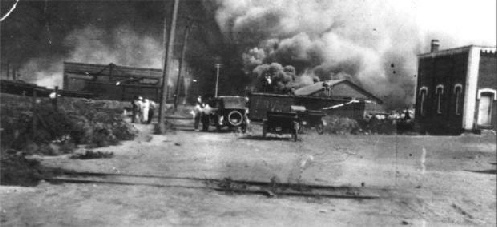

Exploring our past to sort out myth from reality
Share this Page on
Facebook or Twitter

These are the voyages of the TimeShip Anachron.
Our Mission: To boldly explore the past, dispelling
mythinformation and mythconceptions
of American History along the way.
 Visit us on Facebook
Visit us on Facebook
Meet MythAmerica Series

Pt 1 Pt 2 Pt 3 Pt 4 Pt 5 Pt 6 Pt 7 Pt 8 Pt 9
Terrorism on American Soil, Part 5
Holocaust
It is now mid-
As the morning wore on, and the fighting moved northward across Greenwood, there was a startling new development. On the heels of their brief gun battle with African American riflemen to their north, the guardsmen who were positioned along the crest of Sunset Hill then joined in the invasion of black Tulsa, with one detachment heading north, the other to the northeast. As later described by Captain John W. McCuen in the after action report he submitted to the commander of Tulsa’s National Guard units:
“We advanced to the crest of Sunset Hill in skirmish line and then a little further north to the military crest of the hill where our men were ordered to lie down because of the intense fire of the blacks who had formed a good skirmish line at the foot of the hill to the northeast among the out-
More remarkable, the guardsmen came upon a group of African Americans barricaded inside a store, who were attempting to hold off a mob of armed white rioters. Rather than attempt to get the white invaders and the black defenders to disengage, the guardsmen joined in on the attack. Again, as described by Captain McCuen:
“At the northeast corner of the Negro settlement 10 or more Negroes barricaded themselves in a concrete store and dwelling and a stiff fight ensued between these Negroes on one side and guardsmen and civilians on the other. Several whites and blacks were wounded and killed at this point. We captured, arrested and disarmed a great many Negro men in this settlement and then sent them under guard to the convention hall and other points where they were being concentrated.”
No longer remotely impartial, the men of “B” Company, Third Infantry, Oklahoma National Guard, had now joined in on the assault on black Tulsa.
As African Americans fled the city, new dangers sometimes appeared. Mary Parrish later reported that as the group of refugees she was with “had traveled many miles into the country and were turning to find our way to Claremore,” they were warned to stay clear of a nearby town, where whites were “treating our people awfully mean as they passed through”. Similar stories have persisted for decades. [SOURCE: unless otherwise noted, all quotations in this entry are from this source.].
But right in the middle of all of this psychopathic insanity, there were angels of mercy arising! Here are just a few of their stories.
Not all white Tulsans, however, shared the racial views of the white rioters. Mary Korte, a white maid who worked for a wealthy Tulsa family, hid African American refugees at her family’s farm east of the city.
Along the road to Sand Springs, a white couple named Merrill and Ruth Phelps hid and fed black riot victims in the basement of their home for days. The Phelps home, which still stands, became something of a “safe house” for black Tulsans who had managed not to be imprisoned by the white authorities. Traveling through the woods and along creek beds at night, dozens of African American refugees were apparently hidden by the Phelpses during the daylight hours.
Other white Tulsans also hid blacks, or directly confronted the white rioters. Mary Jo Erhardt, a young stenographer who roomed at the Y.W.C.A. Building at Fifth and Cheyenne, did both. After a sleepless night, punctuated by the sounds of gunfire, Erhardt arose early on the morning of June 1. Heading downstairs, she then heard a voice she recognized as belonging to the African American porter who worked there. “Miss Mary! Oh, Miss Mary!” he said, “Let me in quick.” Armed whites, he told her, were chasing him. Quickly secreting the man inside the building’s walk-
“Hardly had I hidden him behind the beef carcasses and returned to the hall door when a loud pounding at the service entrance drew me there. A large man was trying to open the door, fortunately securely locked, and there on the stoop stood three very rough-
“What do you want?” I asked sharply. Strangely, those guns frightened me not at all. I was so angry I could have torn those ruffians apart-
“That nigger,” one demanded, “did you let him in here?”
“Mister,” I said, “I’m not letting ANYBODY in here!,” which was perfectly true. I had already let in all I intended.
“It was at least ten minutes before I felt secure enough to release Jack,” Erhardt added, “He was nearly frozen, dressed thinly as he was for the hot summer night, but he was ALIVE!”
Shown below are the Zarrow family, owners of a grocery store in the riot-
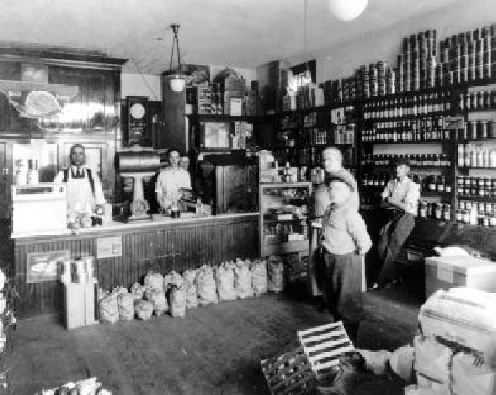
Some whites, in their efforts to protect black Tulsans from harm put themselves at risk. None, perhaps, more so than a young Hispanic woman named Maria Morales Gutierrez. A recent immigrant from Mexico, she and her husband were living, at the time of the riot, in a small house off Peoria Avenue, near Independence Street. Hearing a great deal of noise and commotion on the morning of June 1, Morales ventured outside, where she saw two small African American children, who had evidently been separated from their parents, walking along the street. Suddenly, an airplane appeared on the horizon, bearing down on the two frightened youngsters. Morales ran out into the street, and scooped the little ones into her arms, and out of danger.
A group of armed whites later demanded that Morales hand the two terrified children over to them. “In her English, she told them ‘No’,” her daughter Gloria Lough, later recalled. “Somehow or other,” she added, “they didn’t shoot her.” The youngsters were safe.
But unfortunately, these angels of mercy seem to have been few and far between.
As the battle for black Tulsa continued to rage, it soon became evident, even in neighborhoods far removed from the fighting, that on June 1, 1921, there would be very little business as usual in the city of Tulsa. When Guy Ashby, a young white employee at Cooper’s Grocery on Fourteenth Street, showed up for work that morning, his boss was on his way out the door. “The boss told me there would be no work that day as he was declaring it ‘Nigger Day’ and he was going hunting niggers,” Ashby later remembered, “He took a rifle and told me to lock up the store and go home.”
You would think that since there is no evidence at all of negroes entering white neighborhoods or the business district of Tulsa armed and hostile on June 1, that all “rounding up” of blacks was going on in Greenwood. You would be mistaken.
The riot was felt along the southern edge of the city as well, particularly in the well-
Finally, at 9:15 AM the REAL National Guard arrived.
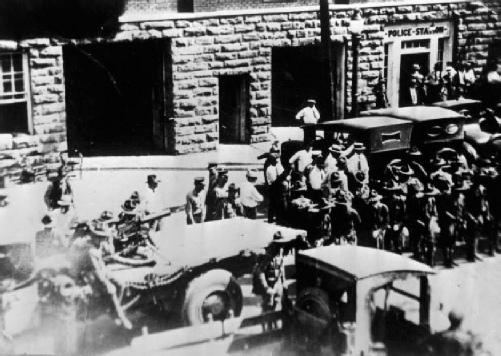
The soldiers, who arrived armed and in uniform, were all-
…By the time the State Troops arrived, Tulsa’s devastating racial conflagration was already ten and one-
And it was too late for them to stop many of the atrocities that had occurred, such as this one reported later by E.W. “Gene” Maxey of the Tulsa County Sheriff’s Department:
“About 8 a.m. on the morning of June 1, 1921,” Maxey told riot chronicler Ruth Avery, “I was downtown with a friend when they killed that good, old, colored man that was blind. He had amputated legs. His body was attached at the hips to a small wooden platform with wheels. One leg stub was longer than the other, and hung slightly over the edge of the platform, dragging along the street. He scooted his body around by shoving and pushing with his hands covered with baseball catcher mitts. He supported himself by selling pencils to passersby, or accepting their donations for his singing of songs.”
How was he killed? Some public psychopaths put a rope around the old man’s stump and tied the other end to their car.
“They went on all the speed that the car could make,” Maxey added, “. . . a new car, with the top down, and 3 or 4 of them in it, dragging him behind the car in broad daylight on June 1, right through the center of town on Main Street.”
The police and “local” National Guard couldn’t be expected to intervene in such insanity, of course … they were busy in Greenwood.
When the State Troops arrived in Tulsa, the majority of the city’s black citizenry had either fled to the countryside, or were being held — allegedly for their own protection — against their will in one of a handful of hastily set-
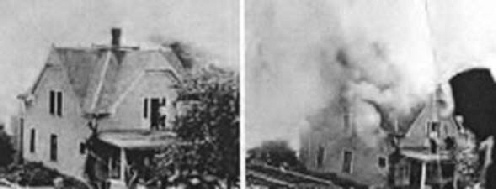
“Remarkably, a handful of Tulsa’s finest African-
As it turned out, while the State Troops were occupied downtown [dealing with “legal” issues involved in declaring martial law], not far away, some of the finest African American homes in the city were still standing. Located along North Detroit Avenue, near Easton, they included the homes of some of Tulsa’s most prominent black citizens, among them the residences of Tulsa Star editor A.J. Smitherman, Booker T. Washington High School principal Ellis W. Woods, and businessman Thomas R. Gently and his wife, Lottie.
For several hours that morning, John A. Oliphant a white attorney who lived nearby, had been telephoning police headquarters in an effort to save these homes, that had been looted but not burned. Oliphant believed that a handful of officers, if sent over immediately, could see to it that the homes were spared. As he later recounted in sworn testimony:
Q. …when you phoned the police station what reply did you get?
A. …somebody in there, I thought I knew the voice but I am not certain, he said, I will do the best I can for you.” I told him who I was, I wanted some policemen, I says, “If you will send me ten policemen I will protect all this property and save a million dollars worth of stuff they were burning down and looting.” I asked the fire department for the fire department to be sent over to help protect my property and they said they couldn’t come, they wouldn’t let them.
Oliphant’s hopes were raised, however, when he observed the arrival of the State Troops, figuring that they might be able to save the homes along North Detroit. “I sent for them,” he testified, “I sent for the militia to come, send over fifteen or twenty of them, that is all I wanted.” But, instead, at around 10:15 a.m. or 10:30 a.m., a party of three or four white men, probably so-
There were a few, very few, that actually did escape burning. Although I doubt any escaped pillaging.
One of the few that was not [burned] belonged to Dr. Robert Bridgewater and his wife, Mattie, at 507 N. Detroit. Returning to his home — after being held at Convention Hall — in order to retrieve his medicine cases, Dr. Bridgewater later wrote,
“On reaching the house, I saw my piano and all of my elegant furniture piled in the street. My safe had been broken open, all of the money stolen, also my silverware, cut glass, all of the family clothes, and everything of value had been removed, even my family Bible. My electric light fixtures were broken, all of the window lights and glass in the doors were broken, the dishes that were not stolen were broken, the floors were covered (literally speaking) with glass, even the phone was torn from the wall.”
The Bridgewaters, as they well knew, were among the fortunate few. Most black Tulsans no longer had homes anymore.
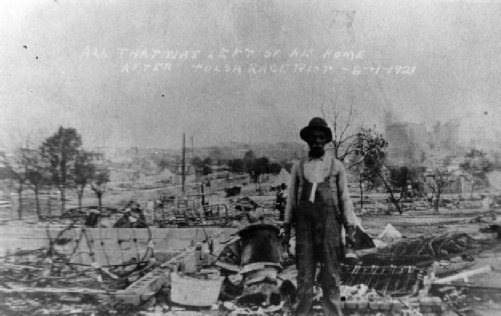
Martial law was finally declared in Tulsa County on June 1 at 11:29 AM.
Following the declaration of martial law, the State Troops began to move into what little remained of Tulsa’s African American neighborhoods, disarming whites and sending them away from the district. After the riot, a number of black Tulsans strongly condemned, in no uncertain terms, the actions of both the Tulsa Police Department and the local National Guard units during the conflict. However, the State Troops were largely praised. “Everyone with whom I met was loud in praise of the State Troops who so gallantly came to the rescue of stricken Tulsa,” wrote Mary Parrish, “They used no partiality in quieting the disorder. It is the general belief that if they had reached the scene sooner, many lives and valuable property would have been saved.”
But they hadn’t. Greenwood was gone.
Additional detachments of State Troops from other Oklahoma cities and towns arrived in Tulsa throughout June 1, and with their help, the streets were eventually cleared. All businesses were ordered to close by 6:00 p.m. One hour later, only members of the military or civil authorities, physicians, or relief workers were allowed on the streets. It was later claimed that by 8:00 p.m. on the evening of June 1, order had been restored. The Tulsa race riot was over.
But the suffering of the survivors was just beginning. When the blacks straggled back to the neighborhoods of Greenwood after being released from “protective custody” in the concentration camps…
What they found was a blackened landscape of vacant lots and empty streets, charred timbers and melted metal, ashes and broken dreams. Where the African American commercial district once stood was now a ghost town of crumbling brick storefronts and the burned-
… Nearly ten-
Across the tracks and across town, in Tulsa’s white neighborhoods, no homes had been looted and no churches had been burned. From the outside, life looked much the same as it had been prior to the riot, but even here, beneath the surface, there was little normalcy.
In one way or another, white Tulsans had been stunned by what had happened in their city. More than a few whites, including those whose homes now featured stolen goods, had undeniably, taken great joy in what had occurred, particularly the destruction of Greenwood. Some whites had even applauded as black families had been led through the streets, at gunpoint, toward the various internment centers. Some would soon find a new outlet for their racial views in the hooded order [the KKK] that was about to sweep across the white community. [Picture below is of the KKK in Tulsa in 1923.]
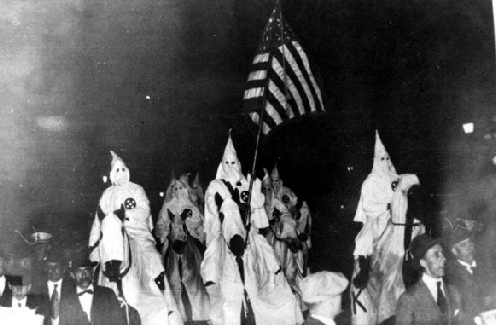
But thankfully, there were others who felt differently. God bless their memory:
Other white Tulsans were horrified by what had taken place. Immediately following the riot, Clara Kimble, a white teacher at Central High School opened up her home to her black counterparts at Booker T. Washington High School, as did other white families.Others donated food, clothing, money, and other forms of assistance. For many whites, the riot was a horror never to be forgotten, a mark of shame upon the city that would endure forevermore.
But in spite of the kindness of some, the indignities didn’t end.
However, for black Tulsans, the trials and tribulations had only just begun. Six days after the riot, on June 7, the Tulsa City Commission passed a fire ordinance designed to prevent the rebuilding of the African American commercial district where it had formerly stood, while the so-
In the end, black Tulsans did rebuild their community, and the fire ordinance was declared unconstitutional by the Oklahoma Supreme Court. Yet, the damage had been done, and the tone of the official local response to the disaster had already been set. Despite the Herculean efforts of the American Red Cross, thousands of black Tulsans were forced to spend the winter of 1921-
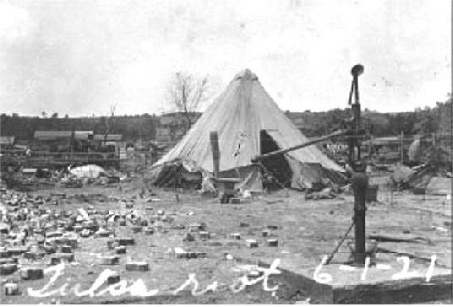
Others simply left. They had had enough of Tulsa, Oklahoma.
For some, staying was not an option. It soon became clear, both in the grand jury that had been impaneled to look into the riot, and in various other legal actions that, by and large, languished in the courts, that African Americans would be blamed for causing the riot. Nowhere, perhaps, was this stated more forcefully than in the June 25, final report of the grand jury, which stated:
“We find that the recent race riot was the direct result of an effort on the part of a certain group of colored men who appeared at the courthouse on the night of May 31, 1921, for the purpose of protecting one Dick Rowland then and now in the custody of the Sheriff of Tulsa Country for an alleged assault upon a young white woman. We have not been able to find any evidence either from white or colored citizens that any organized attempt was made or planned to take from the Sheriff’s custody any prisoner; the crowd assembled about the courthouse being purely spectators and curiosity seekers resulting from rumors circulated about the city.”
“There was no mob spirit among the whites, no talk of lynching and no arms,” the report added, “The assembly [all 2,000 or so of them, milling about in front of the Courthouse…] was quiet until the arrival of armed Negroes, which precipitated and was the direct cause of the entire affair.”
The bottom line?
… no white Tulsan was ever sent to prison for the murders and burnings of May 31, and June 1, 1921. In the 1920s Oklahoma courtrooms and halls of government, there would be no day of reckoning for either the perpetrators or the victims of the Tulsa race riot.
Over a thousand buildings, including a hospital and more than half a dozen churches, were burned to the ground by arsonists—all of them white—in less than one 24 hour period…but it seems that the only folks to blame were those black men who went to the Courthouse at 10 PM on May 31 to try to make sure a 19 year old boy wasn’t lynched. Like so many other citizens had been across America for decades…
But no, the story doesn’t end here. As mentioned earlier, in 1997 what you might call the “cold case files” related to those crimes of 1921 were opened up for scrutiny again. Read about that surprising development in the next section of this series.
